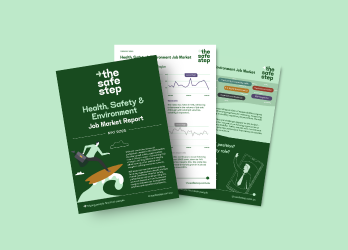Wearable Technology to Improve Safety: A guide for HSE professionals
Page Published Date:
August 24, 2021

Digital disruption of the workplace is well under-way and HSE professionals need to properly appreciate the risks and rewards of emerging technologies. Body cameras, smart glasses, wearable tablets and other wearable safety devices are likely to be the next big thing in safety.
Employers are on the look-out for HSE professionals who understand how to leverage technology to provide new insights and reduce risk. Digital literacy and change management experience related to introducing safety wearables in the workplace are highly valued.
Read on to learn more about wearable computing and discover how to source the right technology stack for your business.
Wearable computing in the workplace
Cameron Stevens, founder of the Safety Innovation Academy became interested in wearable computing when he encountered the limitations of dashboard due-diligence. “I would collect all of this data and fundamentally all the board would see would be a dashboard,” he explained in a recent Safe Step webinar. “That dashboard didn’t really provide a true understanding of the context of those hazards and those risks in the business. It certainly didn’t unpack exactly what was happening with the status of the controls.”
Wearable computing, on the other-hand, provides an extra layer of nuance and context around risks and safety issues. Body cameras can help them see, hear and empathise with workers on the ground. From in-field trouble-shooting, real-time risk assessment, incident evidence collection, digital auditing and safety tours… the possibilities are endless.
Compelling, live audio-visual data helps decision-makers understand the true context of business challenges and give them safe, easy access into worksites they may otherwise have difficulty getting to. Mines, hospitals, construction, heavy industry and worksites in remote locations can all benefit from using wearable computing.
Workplace safety wearables
Wearable computing must be fit-for-purpose, provide high-quality information and be tailored to your individual business needs and work environment. There are a number of things you should consider when making a selection:
- PPE - Body cameras and other wearable computing should in no way compromise other personal protective equipment being worn by your workforce. Consider the use-case context before purchasing technology. How will gloves, hard hats, face masks, eyewear and other PPE impact the fit and function of your technology?
- Situational awareness – Wearable cameras should not interfere with a person’s eyesight, peripheral vision or ability to interact with their work environment.
- Physical burden – Consider the weight of device. Try to limit extra weight around the head, neck and shoulders. Is the set-up suitable for different body shapes, eye dominance and facial features? Will it contribute to eye fatigue? Do cables or the heat of the device pose a risk to the user?
- Privacy – Workers are familiar with carrying around powerful cameras inside their mobile phones but privacy can still be an issue. Some workplaces won’t welcome the intrusion of body-mounted cameras.
- Worksite – Will kit be used indoors or out? Your worksite location will impact the size and brightness of the display. How will chemicals and other hazardous materials affect the technology? Look for rugged splash-proof, drop-proof equipment that’s fit for purpose and built to last.
Choosing the right tech-stack
When developing a business case for wearable technology it’s important to work closely with your IT department. Hardware, software, connectivity and maintenance all have a part to play in forming the right solution.
Safety Technologist Cameron Steven’s tips for choosing the right tech:
Frame rates – Head-mounted solutions should have a minimum 30 frame rates per second. This will prevent the footage from being ‘jittery’ and stop the person watching from feeling seasick.
Noise cancellation – Machinery and high-noise environments can impact the quality of a call. Look for noise cancellation features.
Image resolution – A 16-megapixel camera will give you enough clarity to perform remote assessments. A 720p resolution will be decent, 1080p is even better. For the best quality images aim for 4K streaming which will make you feel like you are physically on site.
Software – This will be dependent on the connectivity of your worksite and can range from Zoom or Microsoft teams to purpose-built software with special video codecs for remote locations.

An example of wearable computing - RealWear's hands-free wearable computer for industrial workers.
Are you ready for change?
When it comes to trialing new technologies in the workplace, change is often the hardest part.
HSE professionals should ensure they have strong digital literacy skills before embarking on such a project. Change management experience will also be of benefit when trying to bring businesses along for the journey.
- Understand the costs. A wearable interface is going to cost around $2,000 - $3,500 per unit once you’ve got everything you need. Roughly the price of a laptop.
- Engage the business early-on. Have open conversations to understand areas of concern. Some workplaces may consider cameras intrusive or have fears about security. Anticipating barriers will help you to overcome them.
- Understand use-case requirements. It’s important that any new technology (the hardware, the software and the connectivity solutions) solves a business problem and meets your use-case requirements. Being innovative is not enough in it’s own right. You must add value.
- Balance opportunity with risk. Could your business gain an advantage by leveraging digital disruption? There are definitely risks associated with wearable technology, but what are the rewards of being an early adopter?
Learn more about making a business case for technology by watching this webinar.
How can we help?
Emerging technologies will have a growing impact on the role of the HSE profession. Businesses that use advances to connect the boardroom with the front line stand to gain a competitive edge. Leaders who familiarise themselves with the trends and are digitally literate can properly appreciate both the risks and rewards of introducing wearable computing and other tech trends.
If you would like more information about implementing wearable computing from Cameron Stevens, or would like information on other emerging HSE trends, please reach out to your Safe Step consultant.
And remember… technology is only as good as the people who operate it. Speak to us if you are looking to Buy, Borrow or Build the HSE capability in your team.
Ramtin Parvar is a Principal Consultant within The Safe Step Melbourne team. Ramtin focuses on mid to senior level recruitment of HSE professionals.




